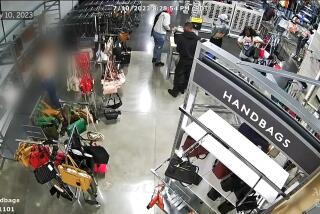Cutting Edge of Secrecy
- Share via
Two decades ago, Iranian students who stormed the U.S. embassy in Tehran found a mountain of paper shredded by American diplomats who were trying to hastily destroy secret documents. The enterprising students brought in carpet weavers, who reassembled the papers, strip by painstaking strip.
The result: volume after volume of classified material, made available in those days at Tehran bookstores. The reconstituted documents became collectors’ items and added to the growing, and sometimes dubious lore of paper shredding.
Now, bankrupt energy trader Enron is adding its own chapter. Recent revelations paint a picture of corporate shredding machines hard at work even as the company went bust and investigators moved in to examine hundreds of suspicious partnership deals.
Like the Tehran experience, the shredding may be all for naught. Modern sleuthing can overcome some of the most devious destruction. Yet the notoriety of the Enron shredding, like many earlier episodes, is almost certain to enhance the perception that the only safe secret is a shredded secret.
In most corporations, the shredder is now as common as water coolers and filing cabinets. Regularly scheduled shredding sessions can legally dispose of documents that in the future might be subject to a subpoena. Whole warehouses of files, and even defective products, have found their way into gnawing electronic teeth.
The National Assn. for Information Destruction, the industry trade association, estimates the number of shredding companies nationwide at around 600, up from perhaps 25 in the early 1980s. Iron Mountain Inc., one of the largest records-management companies in the world, estimates that American businesses spend roughly $300 million a year on shredding documents.
Increasingly, however, that doesn’t mean the data can’t be recovered by investigators. Because most documents are created on computers, then passed along electronically, shredding paper copies eliminates only one version.
Sergio Kopelev, an electronic sleuth for Control Risks Inc., an international business-risk consulting company, said chances are good he could come up with a destroyed Enron document by examining the company’s computer hard drives. (A computer forensics firm has been hired by the Andersen accounting firm to do just that.)
“It would be complicated because of the sheer volume of data you’d have to process,” Kopelev said. “But this kind of procedure is routinely done by computer investigators. I would love to be the one to do it.”
Various parties, meanwhile, are trying to sort out what to do with the thousands of strips of shredded material confiscated in the Enron investigation. As matters now stand, the shreds are in the hands of the Milberg Weiss law firm, which represents a former Enron executive who found them.
The strips of paper have been subpoenaed by the Securities and Exchange Commission. Neither the SEC nor the Department of Justice would comment on any plans to reconstruct the documents, though a spokesman for Milberg Weiss said whole lines of type are clearly visible because the documents were shredded horizontally--as were the Iran embassy documents that were reassembled. That embarrassing incident caused American embassies worldwide to upgrade their shredding machines so they produced confetti rather than paper strips.
How shredding began is subject to some guesswork. Shredder importer Jack Preiss says the first commercial patent was issued in 1935, with a concept borrowed from a Bavarian noodle cutter. Other sources put its invention earlier, including one story of an Austrian artillery officer who developed a foot-powered shredder in the late 19th century so he could destroy his ballistics drawings.
Once merely a tool of institutions such as hospitals that routinely destroyed records to protect patient privacy, shredding blossomed into a truly diverse industry after the Watergate burglary in 1972.
G. Gordon Liddy, mastermind of the break-in, shredded as much as he could find that was connected with the botched burglary, including soap wrappers and $100 bills from illegal campaign funds. But he couldn’t get rid of everything. Liddy later opined in his autobiography that he could have used a much bigger shredder.
“The year before Watergate, I sold 70 shredders,” said John Wagner of Allegheny Paper Shredders, who has installed industrial facilities worldwide. “After Watergate, I sold 400. Everybody’s attitude was, ‘We’ve got to have a shredder.’ ”
Other infamous and market-building shreddings followed. Former Lt. Col. Oliver L. North held a shredding party just before Justice Department investigators began searching his office for evidence in the Iran-Contra scandal. The Bank of Switzerland shredded Holocaust-era documents showing that Nazis forced Jews to sell their property far below its fair value. The Treasury Department fed 162 boxes of American Indian trust fund documents into its shredders in 1998, even as it was accused of mismanaging Indian funds.
Lawyers, industry experts say, provided a key boost in shredding’s popularity when they began advising corporate clients that they could better protect themselves from lawsuits if there were no paper trails. The theory flew in the face of long-standing business practices, in which companies routinely warehoused their records for decades.
“It’s much more prudent to see how long you need to keep records statutorially, then get rid of them,” said Robert Johnson, head of the industry association.
More to the point, it’s a way for companies to say that document destruction is business as usual, thereby protecting them from accusations of shredding incriminating records as investigators are knocking at the door, a la Enron.
All businesses must, at some point, destroy confidential data, and “without proper safeguards, information ends up in the dumpster, where it is readily, and legally, available to anybody,” Johnson said.
Perhaps the most famous of these “dumpster diver” incidents was the case involving former Secretary of State Henry A. Kissinger, whose garbage was picked through by National Enquirer reporter Jay Gourley in 1975. Among the juicy tidbits Gourley found were details of Kissinger’s Secret Service protection, shopping lists, and unopened cans of food. Industry experts say similar dumpster diving is a common form of industrial espionage.
Wagner, of Allegheny Paper Shredders, said the prevalent attitude among most companies is to simply shred everything as standard practice.
“Then they’re safe,” he said. “The simplest way for a company to protect itself is to make sure that everything gets shredded.”
So is there any kind of document that shouldn’t be shredded? Johnson couldn’t think of anything, though he did have a moment of pause some years back when $3 million worth of negotiable traveler’s checks were unexpectedly delivered to his shredding company. After checking with the client bank, the checks were destroyed.
Virtually all Fortune 500 companies now use shredders or employ shredding services on a regular basis. Shredders range from industrial models--hulking machines capable of swallowing tons of material an hour--to personal models that fit atop office waste baskets. Personal shredders, which can be found at most office supply stores, range in price from under $50 to more than $300.
Shredding, though, isn’t just for paper. These days shredding means destroying most everything, from bottles and cans to defective condoms. Casinos often use shredders to destroy worn-out betting chips, used dice and playing cards. Old tires, carpet, syringes and even crab shells are routinely pulverized in these machines whose huge steel jaws can turn most anything to dust.
Wagner recalled one instance in which eight trailer loads of defective toys were shredded at a South Carolina plant. In another case, he said 225 trailers filled with video game rejects had to be shredded in 30 days. To prevent knockoffs from ever reaching the market, here or abroad, fake Rolex watches, bogus Gucci purses and counterfeit tennis shoes also have found their way to the shredding machines.
Peter Dempsey, president of Security Engineered Machinery, began providing U.S. Navy ships with shredders after the 1968 Pueblo incident, when the American spy ship could not get rid of all its secret documents after being captured by North Korea.
Dempsey said that in addition to providing shredding machinery to the Navy, his company shreds U.S. currency and postage stamps. The currency is cut into tiny specks of paper and deposited in landfills. “We like to say we make money by destroying it,” Dempsey said.
Over the years, a number of Academy Award statuettes had been turned back over to the Academy of Motion Picture Arts and Sciences, mostly because of dents and scratches from falls. (For $350, the owners got new ones.) About seven years ago, Academy Executive Director Bruce Davis noticed his closet was filled with the statuettes, 15 in all. He was faced with the dilemma of what to do with them. Tossing them in the trash was out of the question because odds were they would be retrieved and sold.
“They’d show up on EBay two days later and you end up with a dignity problem,” said Davis, who eventually approached the company that handled the academy’s paper shredding. No problem, said Shred It of Los Angeles.
Davis watched as the first of the damaged Oscars was fed into the machine. “These jaws ate it up and turned it into shrapnel.”
*
RELATED STORY
Following the money: Forget accountants as milquetoasts. They’ve got a sexier rep now. E1
More to Read
Inside the business of entertainment
The Wide Shot brings you news, analysis and insights on everything from streaming wars to production — and what it all means for the future.
You may occasionally receive promotional content from the Los Angeles Times.










